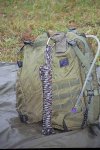That's a nice link Steven!
Brought back some memories of dismounted land nav while I was in the Army many moons ago.
What you need to do to figure out pace count is to measure out 100 meters, count how many times your left foot hits the ground one way, count again coming back, and average the two. In my case (5'10") it takes me 69 paces for 100 meters.
Going uphill, your count gets bigger since you take shorter steps. Downhill, your count gets smaller since you take longer strides.
If possible, set up an uphill and downhill practice lane. This is really guesstimation however because the steepness of the terrain differs and so will your pace count. That is why it helps to have a map. You can compare the contour lines to your progress.
Practice, practice, practice!
I just picked up a set of skull pace count beads from
CSM Tactical Gear under the accessories section.
The beads cost $3.00 USD and with tax and shipping (I live in CA) it was still under $4.00.
Some troops complained that the skull beads are too fragile, but I've had these for a month without any problems. They may have got theirs from USCavalry since CSMGear just started listing these a little over a month ago.
I have them on my keyring (with lots of keys, an Arc AAA, UtiliKey, and a small whistle from REI) so it gets banged around alot along with any change in my pocket. It has still held up without any problems.
I loop it next to the house key so when I pull them out, my keys are indexed pretty quickly and I don't have to go fumbling around.

